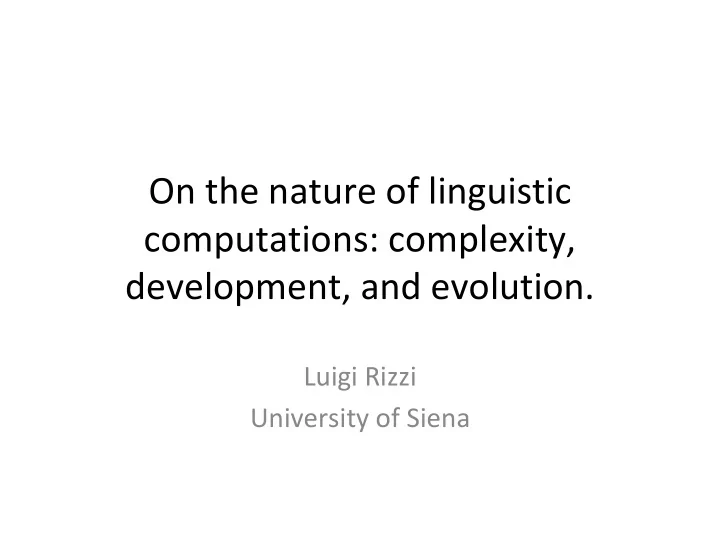

On the nature of linguistic computations: complexity, development, and evolution. Luigi Rizzi University of Siena
Structure of the talk I. Language as a computational system: Some elements of linguistic computations: Structure building, • movement, interfaces, locality. How to model language invariance and variation: On the format • and locus of parameters. II. Language variation and language acquisition: On the early acquisition of abstract word‐order properties: an • experimental result. III. A typology of Merge: a complexity scale and its implications for language acquisition, adult knowledge of language and, possibly, for the evolution of language.
The unbounded scope of the human linguistic capacities • We constantly understand and produce new sentences, combinations of words that we have never encountered in our previous linguistic experience • … and still we find them familiar and usable. • Galileo, Descartes, Humboldt,…
Elements of syntactic computations: generative models • The linguistic capacities can be modelled as the possession of a computing machine (Chomsky 1957), consisting of at least two kinds of entities: • ‐ Inventories , lists of elements stored in memory (words,…) • ‐ Computational procedures , putting together elements drawn from the inventories to form higher order units (phrases, sentences,…), recursive. • PHON SYNTAX SEM
Alternatives to a computational approach? Could it be that we just memorize fragments, sequences of words and retrieve and reuse them? ‐ No: we clearly have the capacity to go beyond what we hear and generate new structures. Could it be that we create new sentences through analogical generalization from memorized fragments? ‐ This statement acquires a content only if we try to make precise what “analogical generalization” means, thus explaining why certain conceivable “analogical generalizations” are never considered by the language learner.
Recent developments: Inventories • Inventories: shift of emphasis from the contentive lexicon (N, V, A,…) to the functional lexicon (D, Aux, C, T, Asp,…) Functional elements: ‐ create configurational skeleta for the insertion of contentive elements; ‐ trigger the fundamental computational processes; ‐ express basic parameters of variation; ‐ give rise to complex configurations, studied in “cartographic” projects (Rizzi 1997, Cinque 1999, etc).
Recent developments: elementary computations • Computations: shift from concrete, construction‐ oriented rules (for relatives, questions, passives,…) to more abstract computational ingredients: ‐ Merge, ‐ Move, ‐ Spell‐out.
Merge as the fundamental recursive procedure • Merge: C 2 (1) A B A B where C = A, or C = B: the selecting element projects. Chomsky (1995, 2001)
A derivation [ meet Bill ] [ can [ meet Bill ]] [ Mary [ can [ meet Bill ]]] [ that [ Mary [ can [ meet Bill ]]]] [ said [ that [ Mary [ can [ meet Bill ]]]]] [ has [ said [ that [ Mary [ can [ meet Bill ]]]]] [ John [ has [ said [ that [ Mary [ can [ meet Bill ]]]]]
A tree (3) T 3 N T John 3 T V has 3 V C said 3 C T that 3 N T Mary 3 T V can 3 V N meet Bill
A development: the cartography of syntactic structures ‐ the C system (Rizzi 1997, 2004) Force P 3 3 Force TopP 3 3 Top IntP 3 3 Int Foc P 3 3 Foc ModP 3 3 Mod FinP 3 3 Fin Clause
Recommend
More recommend